| Autographs & Historical Documents |
| |
| |
| Lot |
Photo |
Description |
Lot 1001 |
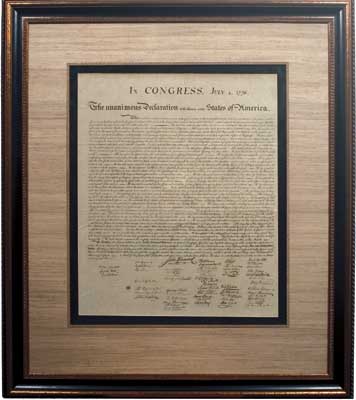 |

Declaration of Independence (July 4, 1776), Printed document signed in facsimile, one page, large folio, from The American Archives, being an official rice paper copy of the Declaration of Independence, pulled from the Stone copper plate by Peter Force in 1843. Some typical tears that have been reinforced, Well preserved, archivally framed, Very Fine.
Estimate 20,000 - 30,000
A RARE OPPORTUNITY TO OWN AN EARLY AND AUTHORIZED PRINTING OF THE MOST IMPORTANT DOCUMENT IN AMERICAN HISTORY.
In 1823, Congress authorized the production of facsimile copies of the Declaration of Independence. Noted engraver, William J. Stone, was commissioned to use a new wet-ink transfer process to the copper-plate, which was then used for printing. There were 201 copies made in this early printing, of which only 31 examples are currently known with only twelve in private hands.
In 1843, Peter Force used the original Stone copper-plate to print additional copies of the Declaration of Independence on rice paper for inclusion in Volume I of his multi-volume book, "American Archives". Congress authorized up to 1500 copies of the book to be printed, but subscriptions fell far short of this number. The actual number printed is unknown, with estimates ranging from about 500 to upwards of 1000 copies. All examples were folded for insertion on the inside of the front cover of Volume I, but today, most have been removed. Because the twelve privately owned 1823 parchment copies are prohibitively expensive, the remaining rice paper copies are highly desirable.
View details and enlarged photo
|
Lot 1002 |
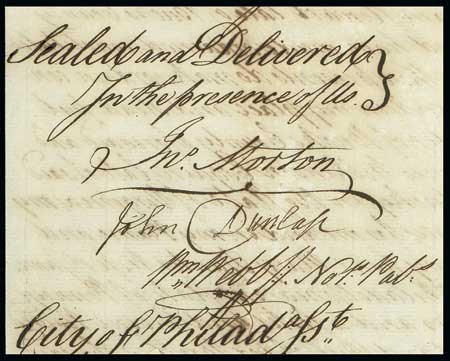 |
Dunlap, John (1747-1812), Printer of the Declaration of Independence.
Signature as witness to Hannah Harris' March 15, 1784 power of attorney to John Hunter, presented to the Lincoln County court of Pennsylvania on June 15; some erosion at top of inner leaf, Fine.
Estimate 1,000 - 1,500
John Dunlap, as a boy, lived with an uncle, William Dunlap who was a printer and publisher in Philadelphia. At the age of eighteen he entered the business, and in November 1771 began the publication of the Pennsylvania "Packet". This paper was changed into a daily in 1784, the first in the United States, and afterward became the "North American and United States Gazette". Mr. Dunlap was appointed printer to congress, with his first major task being the "Declaration of Independence" printing.
View details and enlarged photo
|
Lot 1003 |
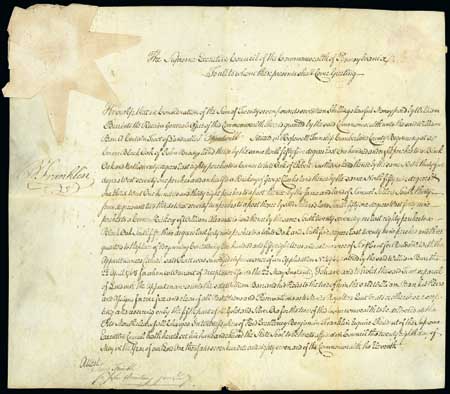 |
Franklin, Benjamin (1706-1790), DS, signed as president of the executive council of Pennsylvania, one page folio on vellum, dated May 28, 1787, a land grant by the Supreme Executive Council of Pennsylvania to William Barr of "a certain tract of land called 'Speedwell', situated in Hopewell Township Cumberland County", very large signature of "B. Franklin" at left below the paper and wax seal; some aging, Very Fine.
Estimate 7,500 - 10,000
Provenance: Dr. Max Thorek
Benjamin Franklin was president of the executive council of Pennsylvania from 1785 to 1788 among his many duties.
View details and enlarged photo
|
Lot 1004 |
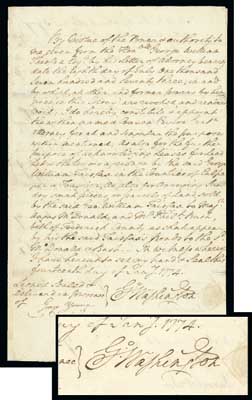 |
Washington, George (1732-1799), First President of the United States.
ADS, Jan 7, 1774 folio on the appointment of Craven Peyton as attorney to oversee the lands of George William Fairfax in Culpepper and Fauquier counties of Virginia, lengthy document all in Washington's hand, signed "G. Washington", verso of document appointing Craven Peyton as collector of rents, June 18, 1773, signed "G.W. Fairfax" and co-signed by "Lancelot Lee" of Va., minor restoration not affecting the signatures, Fine.
Estimate 25,000 - 30,000
AN IMPORTANT DOCUMENT CONTAINING SIGNATURES OF THE MOST PROMINENT FAMILIES IN VIRGINIA; WASHINGTON, FAIRFAX, AND LEE.
At the early age of 16, George Washington helped survey Shenandoah lands for Thomas Fairfax, the sixth Lord Fairfax. Lord Fairfax was a friend and patron of Washington's early life. Over the following years, George Washington would develop a close relationship with George William Fairfax, the son of Thomas's first cousin. George William Fairfax returned to England in 1773, leaving Washington to look after the Fairfax's affairs in Virginia.
Lancelot Lee was a cousin to Robert E. Lee descending from the "Stratford" line of the Lee family that originates from Richard Lee (1647-1714).
View details and enlarged photo
|
Lot 1005 |
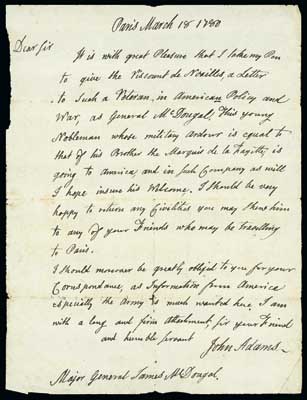 |
Adams, John (1735-1826), Second President of the United States.
ALS, one page, 7¼ x 9½ datelined "Paris March 18 1780", written to Major General James McDougal - actually Alexander McDougal (1732-1786), introducing Lafayette's brother, Vicomte de Noailles, Very Fine with text and signature fresh.
Estimate 20,000 - 25,000
OUTSTANDING REVOLUTIONARY WAR DOCUMENT MENTIONING LAFAYETTE, AND ILLUSTRATING THE PERSONAL RELATIONSHIPS BETWEEN AMERICA AND FRANCE.
Alexander McDougal was an officer in the Continental Army who fought with distinction during the New York campaign and at Germantown, before being promoted to major general and serving at Hudson Heights and at West Point following the demise of Benedict Arnold. At this time, Adams was traveling to his post as minister to Holland, and had detoured to Paris in order to negotiate a peace settlement with the British, though also to secretly persuade the French Government to provide more aid to the Revolution.
The introduction starts, "It is with great pleasure that I take my pen to give the Viscount de Noailles, a letter to such a Veteran in American Policy and War, as General McDougal. This young Nobleman whose military ardour is equal to that of his Brother the Marquis de la Fayette, is going to America, and in Such Company as will I hope insure his welcome…"
The Marquis de Lafayette had already seen battle in America, having commanded a division of Virginia light infantry at the Battle of Monmouth and leading two brigades at Newport. His brother-in-law, the Vicomte went on to personally command the French troops that turned back the last British sortie at Yorktown and represented the French during pre-surrender negotiations.
View details and enlarged photo
|
Lot 1006 |
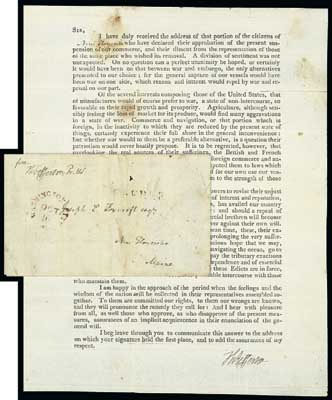 |
Jefferson, Thomas (1743-1826), Third President of the United States.
Free-franked "free Th. Jefferson Pr. US" on outer leaf with inner leaf broadside concerning the Embargo duly signed, circular mailed to New Gloucester Mass. with rimless "Washington City Oct 16" postmark and matching "Free" handstamp; outer leaf with minor erosion mostly along folds, toning mostly affecting outer leaf, Very Fine.
Estimate 15,000 - 20,000
AN IMPORTANT DOCUMENT COMMUNICATING THE REASONS FOR THE CURRENT EMBARGO TO AVERT THE IMPENDING WAR.
The circular is a response to citizens of Gloucester "who have declared their approbation of the present suspension of our commerce, and their dissent from the representation of those of the same place who wished its removal." Following is an explanation of the differing factions is presented, "Of the several interests composing those of the United States, that of manufacturers would of course prefer to war, a state of non-intercourse, so favorable to their rapid growth and prosperity. Agriculture, although sensibly feeling the loss of market for its produce, would find many aggravations in a state of war. Commerce and navigation, or that portion that is foreign, in the inactivity to which they are reduced by the present state of things, certainly experience their full share in the general inconvenience…" And an overall summation of "The Embargo, giving time to the belligerent powers to revise their unjust proceedings, and to listen to the dictates of justice, of interest and reputation, which equally urge the correction of their wrongs, has availed our country of the only honorable expedient for avoiding war: and should a repeal of these Edicts supersede the cause for it, our commercial brethren will become sensible that it has consult their interests, however against their own will."
View details and enlarged photo
|
Lot 1007 |
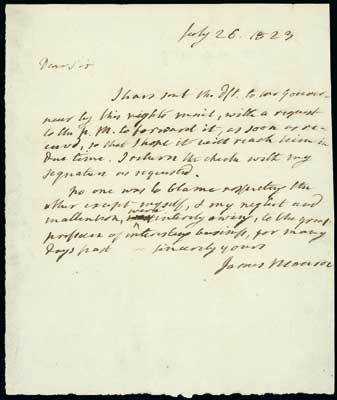 |
Monroe, James (1758-1831), 5th President of the United States.
ALS as president, 1 page, 6¼ x 7½", July 26, 1823 letter in his hand stating that he had "sent the dft. to Mr Gouverneur near by this nights mail, with a request to the P.M. to forward it, as soon as received, so that I hope it will reach him in due time. I return the check with my signature as requested", Very Fine and fresh.
Estimate 3,000 - 4,000
INTERESTING LETTER THAT MENTIONS FORWARDING BY THE POSTMASTER AS SOON AS RECEIVED.
The mailing that Monroe mentions is to his son-in-law, Samuel Lawrence Gouverneur, who married his youngest daughter, Maria.
View details and enlarged photo
|
Lot 1008 |
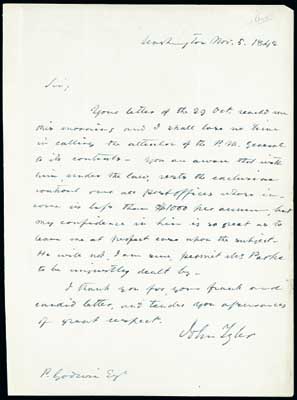 |
Tyler, John (1790-1862), 10th President of the United States.
ALS, signed as President, one page letter datelined "Washington November 5, 1842" to P. Godwin with interesting content concerning the Postmaster General and postal affairs; Very Fine and fresh.
Estimate 2,000 - 3,000
Letter reads in part, "Your letter of the 29 Oct. reached me this morning and I shall lose no time in calling the attention of the P.M. General to its contents. You are aware that with him, under the law, rests the exclusive control over all post offices whose income is less than $1000 per annum, but my confidence in him is so great as to leave me at perfect ease upon the subject. He will not, I am sure, permit Mr. Parke to be unjustly dealt by…" The Postmaster General at this time was Charles A. Wickliffe.
View details and enlarged photo
|
Lot 1009 |
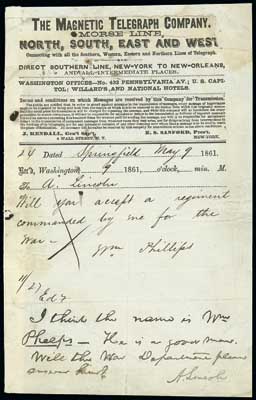 |
Lincoln, Abraham (1809-1865), 16th President of the United States.
AES, "A. Lincoln", 1p, 5" x 8" (Washington DC). Undated endorsement, as president, on a telegram sent from Springfield, Ill. to Lincoln on May 9, 1861. Magnetic Telegraph Co. form to "A. Lincoln" with a message that reads simply "Will you accept a regiment commanded by me for the war.- Wm. Phillips". At the bottom Lincoln has written "I think the name is Phelps - He is a good man. Will the War Department please answer him? A. Lincoln".
Repaired at the top with a reinforcing strip along the left edge. A Fine and attractive Lincoln presidential document.
Estimate 10,000 - 15,000
THE DOCUMENT OFFERS AN INSIGHT INTO THE HANDS-ON APPROACH LINCOLN WOULD TAKE IN THE WAR.
The note would presumably have been sent to Simon Cameron, Lincoln's first Secretary of War.
View details and enlarged photo
|
Lot 1010 |
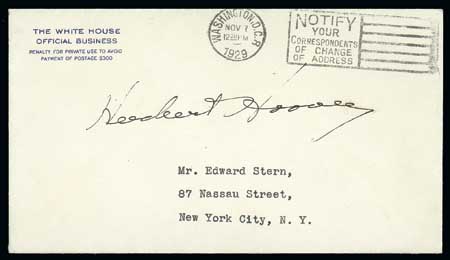 |

Herbert Hoover (1874-1964), 31st president of the United States, free frank as President on White House penalty envelope to Edward Stern in New York, "Washington, D.C. Nov 7 1929" slogan cancellation, Very Fine and rare.
Estimate 4,000 - 6,000
ONE OF ONLY THREE RECORDED COVERS FRANKED BY HERBERT HOOVER WHILE IN OFFICE.
Expertization: PSA/DNA Letter of Authenticity.
Provenance: Stern
The three recorded Hoover presidential franks are:
1. 1929 Nov. 7, Ex-Stern, the example offered here.
2. 1930 Jan. 21, Ex-Kantor, Robertson.
3. 1930 Apr. 8, Ex-Hessel.
View details and enlarged photo
|
Lot 1011 |
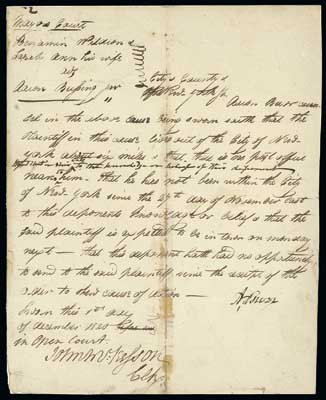 |
Burr, Aaron (1756-1836), Third Vice President, infamous duel with Alexander Hamilton, tried for treason.
ADS, 1 page, signed "A. Burr" on court document transcribed and signed by the clerk on Dec. 1, 1820 in the case of Benjamin Wildion verse Aaron Bussing, Aaron Burr was the counsel for the plaintiff in the case making a sworn statement that the plaintiff lives outside the City of New York about six miles and that there were no post offices to send return receipt of the order to show cause of action; affixed to backing paper, slight glue stains, Fine.
Estimate 500 - 750
After an infamous duel with Alexander Hamilton in 1804 and his later trial for treason, Aaron Burr attempted a political comeback that was dashed. He fled America and his creditors for Europe, where he tried to regain his fortunes where he lived from 1808 to 1812. Burr returned quietly to New York in 1812, living his remaining days as a moderately successful attorney until his death in 1836.
View details and enlarged photo
|
Lot 1012 |
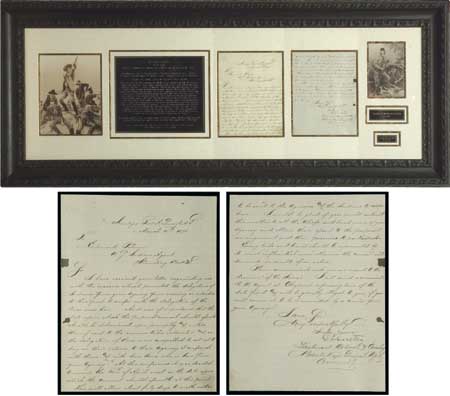 |
Custer, George Armstrong (1839-1876), U.S. Army Bvt. Major General, Indian fighter, died at Little Bighorn along with more than 260 of his men.
LS, "G.A. Custer", two pp (one lined sheet, two sides), 8½" x 11", Headq'rs, Fort A. Lincoln, March 11, 1875. Letter to (Major) Edmond Palmer, U.S. Indian Agent at Standing Rock, Dakota Territory, penned by one of Custer's personal scribes, acknowledges reasons why Indians from Palmer's agency were not able to meet with a delegation of Rees at Fort Lincoln but that after conferring with the Rees and "Iron Horse…from your agency", urges that Palmer "submit to all the Chiefs and head men of your agency" Custer's intention of holding a large Indian peace council and that "Every tribe and band should be represented by its most influential men otherwise the council will terminate in results of no value." and "Please communicate with me in regards to the decision of the Sioux." Custer has added his bold signature as Lieutenant Colonel of Cavalry and Brevet Major General of the U.S. Army, Commanding.
The letter is Very Fine with small file holes in right margin along with about a half-inch of paper loss. The letter is beautifully framed to an overall 55" x 22" in "Gallery of History" style displaying the verso of the letter with the marvelous signature beside a copy of the front of the letter so that the full text may be viewed; also in the frame are a 9" x 11" engraved plaque with the complete transcription of the letter and two images of Custer in frontier Garbenteich.
Estimate 10,000 - 15,000
A FINE LETTER FROM CUSTER WITH EXCELLENT INDIAN CONTENT.
Expertization: University Archives and PSA/DNA Letters of Authenticity.
A little over a year later, on June 25-26, 1876, Custer would meet his death in the Battle of Little Bighorn at the hands of these same Sioux, who refused to live within the boundaries of the Great Sioux Reservation, which encompassed most of present-day South Dakota west of the Missouri River.
View details and enlarged photo
|
Lot 1013 |
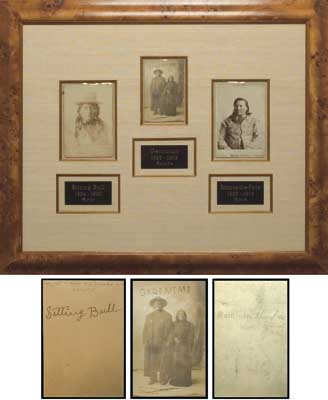 |
Photographs signed by Indian Chiefs Geronimo, Sitting Bull and Rain-in-the-Face, three signed photographs comprising; Geronimo (1829-1909) Apache Indian Chief who who resisted government removal of their people from treaty-guaranteed reservations in the late nineteenth century, leading raids and by 1885 an all-out campaign against white settlements in parts of Arizona and New Mexico, he was taken federal prisoner in 1886. Real sepia-toned picture postcard of Geronimo and his wife, signed "Geronimo" in pencil; from the collection of L.B. Deming Jr. whose grandparents were personal friends of Geronimo, letter of provenance; Sitting Bull (1831-1890) Lakota Sioux Medicine Man and Chief prophesized the Custer massacre and was with Gall and Crazy Horse at the Battle of Little Big Horn, considered the last Sioux to surrender to the U.S. government, Cabinet Card photograph taken by George Scott of Dakota Territory, boldly signed "Sitting Bull" in ink on verso; Rain-in-the-Face (1835-1905) Lakota Sioux War Chief among the Indian leaders who defeated Custer at Little Big Horn, Cabinet photograph, half-length seated portrait taken by Army photographer George Spencer at the World's Fair in 1893, bold "Rain in the Face" signature in pencil on verso with "written by himself W.G.L." below; All three images professionally mounted and framed together, Very Fine.
Estimate 25,000 - 30,000
AN EXCEPTIONAL DISPLAY OF THESE HISTORICALLY IMPORTANT INDIAN CHIEFS.
View details and enlarged photo
|
Lot 1014 |
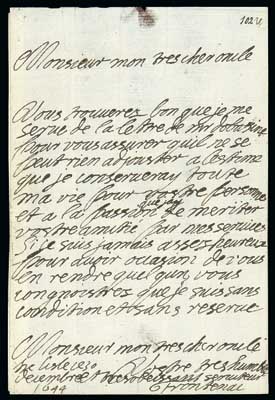 |
Frontiac, Comte de Louis (1622-1698), Colonial Governor of New France.
ALS, one page, 6¼" x 4¼", letter in French dated December 30, 1644, addressed on reverse to his uncle, Monsieur d'Humieres, signed my Dear Uncle, Your Obedient & humble servant, "Frontiac", Very Fine and choice.
Estimate 3,000 - 4,000
The letter transcribed reads, "My Dear Uncle, You will find it good that I serve myself with the letter of Monsieur Dobasine to assure you that he cannot adjust anything, for certainly I will devote all my life to your person and to the passion which I have to serve your friendship for my services…I am ever happy for the occasion to render that which I am able without conditions and without reserve."
Frontenac was a French courtier and Governor of New France from 1672 to 1682 and from 1689 until his death in 1698. He established a number of forts on the Great Lakes and engaged in a series of battles against the English and the Iroquois during King William's War, a successful campaign that resulted in the elimination of the Iroquois threat against New France, and a large expansion of the fur trade using Canadian coureurs des bois.
View details and enlarged photo
|
Lot 1015 |
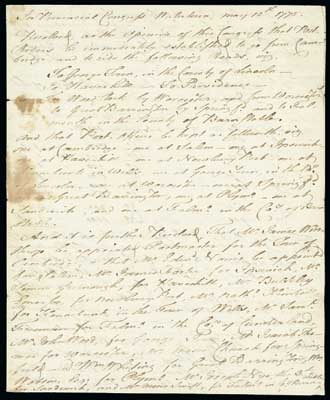 |
Massachusetts Act of May 12, 1775 creating an Independent Postal System, folded letter sheet datelined "In Provincial Congress Watertown, May 12th 1775", the copy of the Act approved on May 18, 1775 that created an independent postal system in Massachusetts, which New Hampshire latter joined, originally signed by Joshua Warren, Samuel Freman, and on May 18 by Matthew Thornton and E. Thomson; small stain spot, otherwise Very Fine, an important historical document describing the postal matters during the Revolutionary Period.
Estimate 3,000 - 4,000
THE ONLY RECORDED ORIGINAL HANDWRITTEN COPY OF THE ACT APPROVED MAY 12, 1775, CREATING AN INDEPENDENT POSTAL SYSTEM IN MASSACHUSETTS.
The copy reads in part, "Resolved, as the Opinion of this Congress that Post Riders be immediately established to go from Cambridge, and to ride the following road, viz. To George Town, in the County of Lincoln - To Havehill - To Providence - To Woodstock by Worcester, and from Worcester to Great Barrington by Springfd. and to Falmouth, in the County of Barnstable.
And that Post Offices be kept as followith, viz. one at Cambridge - One at Salem, one at Ipswich - one at Havehill - one at Newbury Port - one at Kennebunk in Wells, one at George Town, in the Cty. of Lincoln - one at Worcester - one at Springfield - one at Great Barrington, one at Plymo. - one at Sandwich - and one at Falmo. in the Coy. of Barnstable."
The copy continues with various post office business including postmaster appointments and the rate table by distances. Rates include 5¼d for up to 60 miles, 8d for 60-100 miles, 10½d for 100-200 miles, 1sh 1d for 200-300 miles, etc. Additional section dated May 18th, 1775 added Portsmouth New Hampshire to the independent postal system. Also noted, is that Connecticut has already taken of the business of setting up an independent postal system.
View details and enlarged photo
|
Lot 1016 |
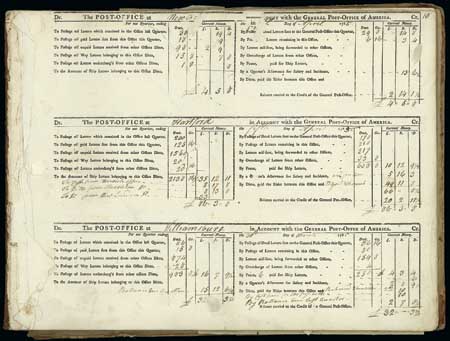 |

1785-88, Postal Accounting Book from the Confederation Period, printed General Post Office bill book with quarterly receipts from 5 April 1785 to 5 January 1788 with approximately 100 entries, printed headings "The POST-OFFICE at ……, in Account with the General Post-Office of America", post offices are filled in such as "Hartford", "Williamsburg", "Annapolis", "Washington", "Colchester", etc., manuscript breakdowns of various letter postage including way letters, ship letters, etc. ending with an accounting of the "Balance carried to the Credit of the General Post-Office"; some pages clipped, Fine and interesting historical postal document.
Estimate 5,000 - 7,500
THE ONLY SURVIVING AMERICAN ACCOUNTING BOOK FROM THE 18TH CENTURY PERIOD IN PRIVATE HANDS.
View details and enlarged photo
|
|